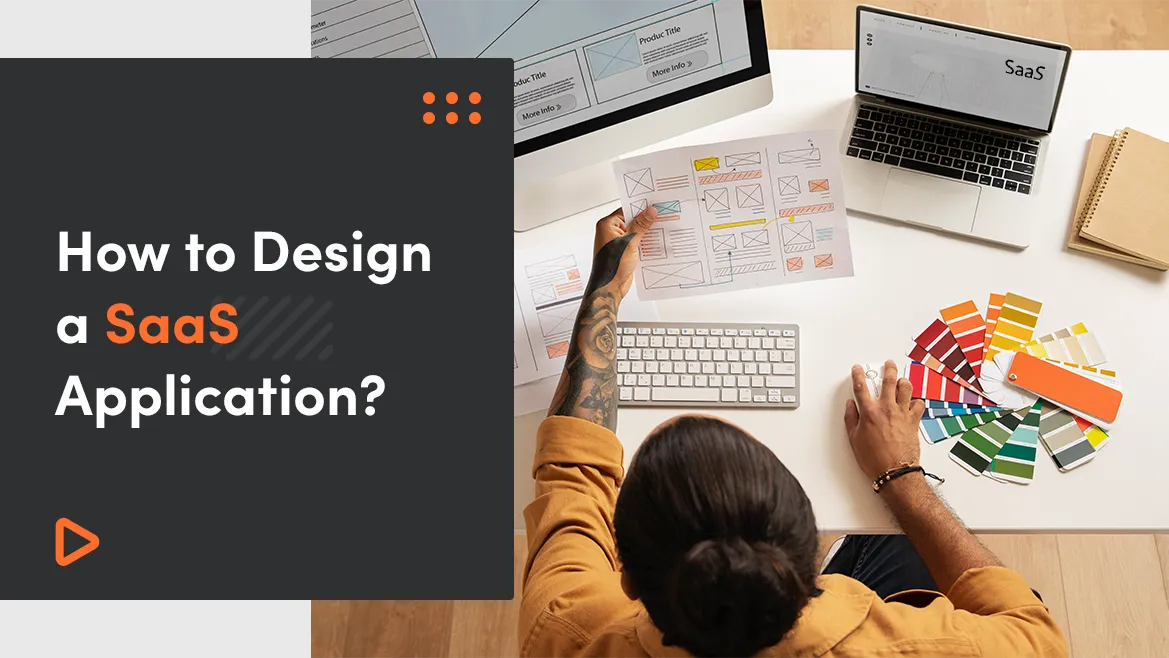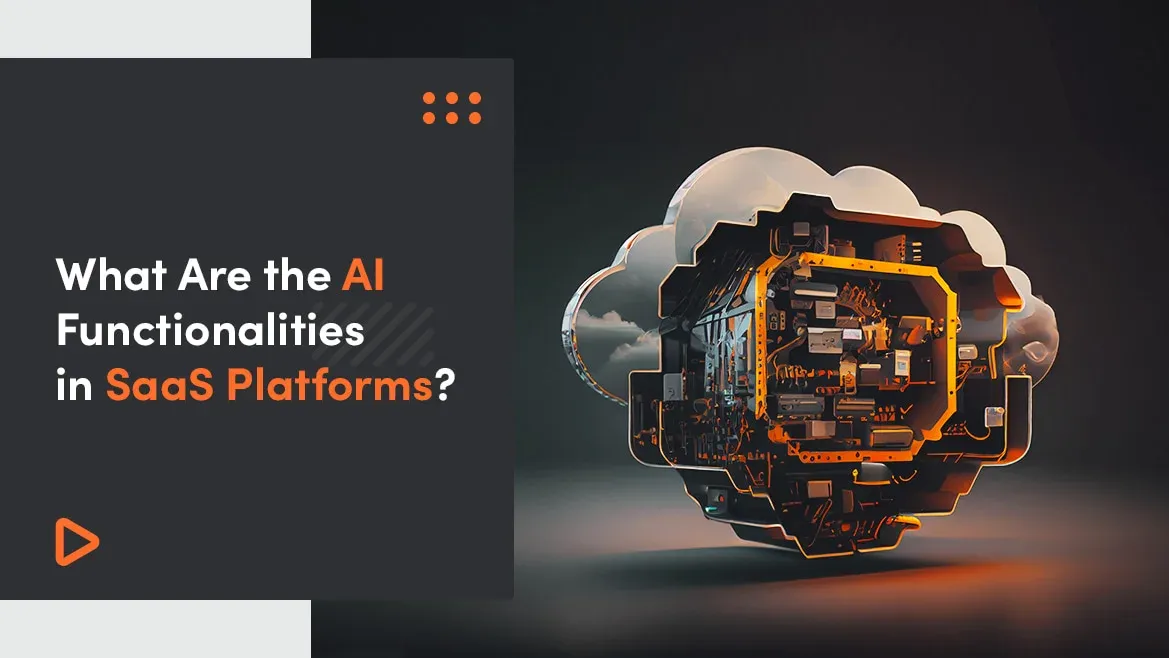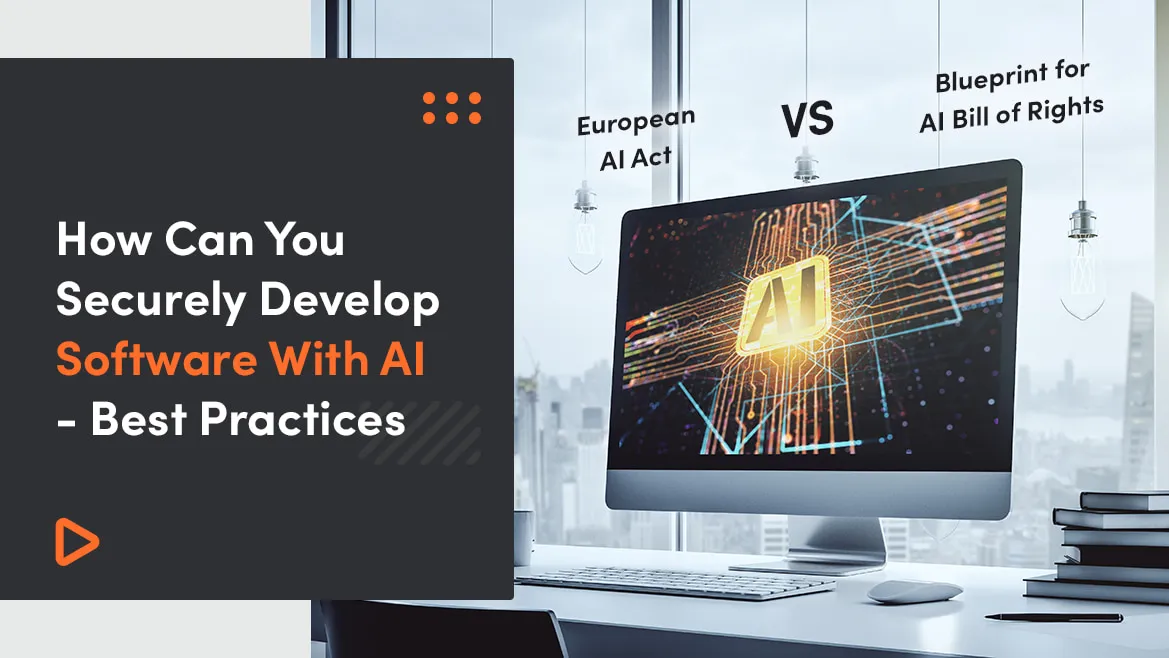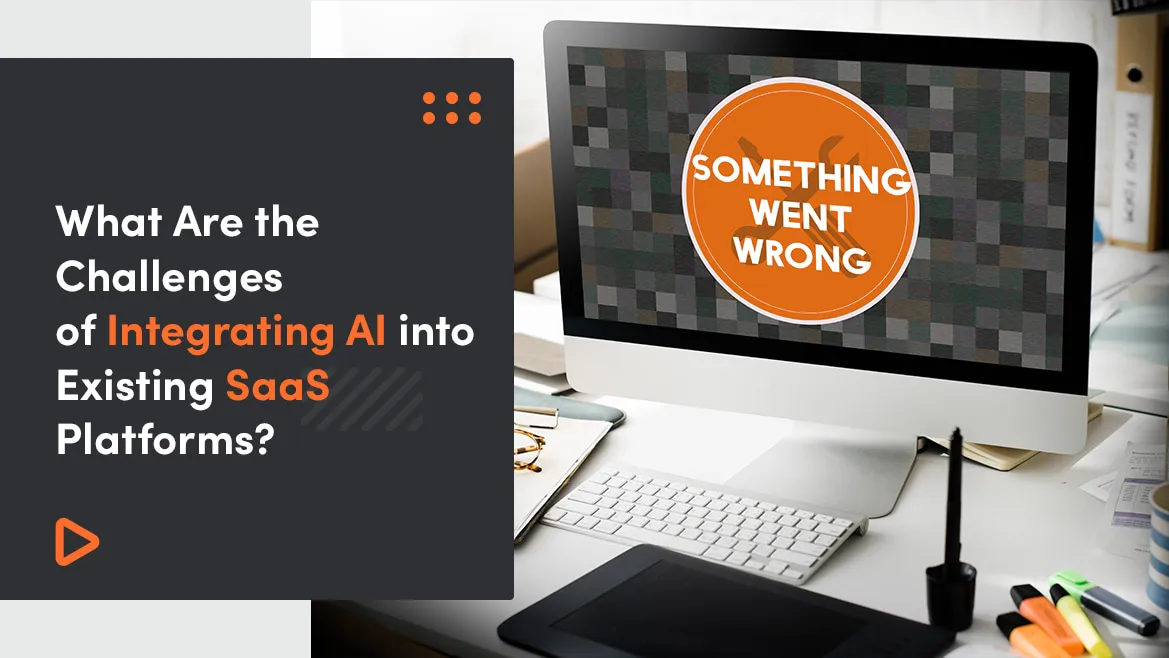There are not only technical differences between SaaS and bespoke application design, there are also philosophical differences.
In this article, I will blend the business and technical aspects of designing SaaS apps to help you design a more successful product.
After reading this article, you will learn:
- How does SaaS differ from traditional software in terms of deployment and licensing?
- What is the significance of SaaS architecture in today's software development landscape?
- What are some of the challenges that developers might face in SaaS application development, according?
- How can a SaaS product gain the trust of its customers, especially when entering a competitive market?
- What is the importance of defining a unique value proposition for a SaaS product?
- How does multi-tenancy affect the development and security of SaaS applications?
- What factors should businesses consider when choosing a pricing strategy for their SaaS products?
-
Focus on Solving a Real Problem - before development begins, validate the problem you're solving with potential users to ensure there’s a market need.
-
Start with a Minimum Viable Product (MVP) - this approach helps gather early feedback, iterate quickly, and avoid spending too much time on unnecessary features.
-
Scalability and Security from Day One - prioritize cloud infrastructure that supports scalability and ensure robust security practices (data encryption, secure authentication, compliance) to protect user data.
-
Intuitive User Interface and (UX) is Crucial - app in user-centred design to ensure your app is easy to navigate, offers clear onboarding, and provides helpful support resources. A confusing UI can lead to high churn rates.
-
Choose the Right Technology Stack and Tools - select a tech stack that fits your app’s requirements and future growth plans. Consider using multi-tenant architecture, APIs, and cloud platforms to maintain flexibility. Additionally, utilize tools for continuous integration/continuous delivery (CI/CD), monitoring, and analytics to support ongoing development and maintenance.
What is SaaS?
SaaS which stands for Software as a Service, is the most popular cloud computing solution. It refers to software that runs on the infrastructure of the SaaS providers. This entails providing and maintaining software through a subscription model. The SaaS product is hosted in a cloud environment, eliminating the need for installation on a computer and the sale of lifetime licenses.
Users of such software do not have to deal with complicated configurations or updates. They always have access to the newest versions of the software. Such programs can be used anywhere in the world, from any device and both a web browser even without an internet connection. A great example of a Software as a Service business model is Adobe’s Creative Cloud - which moved from traditional software to a SaaS model.
SaaS offers benefits like:
- Security: cloud provider ensure maximum security of customer data and data security and all data,
- Cost efficiency: no need to buy and maintain hardware,
- Reliability: servers can be located around the world so even if one of them goes down, the app will remain online,
- Scalability: you can upgrade or downgrade your plan with a few simple clicks according to your requirements.
What is more, a SaaS-based application can be used on multiple devices (including mobile devices) with a single login, contrary to traditional software. Users also usually have the opportunity to test the software before buying the subscription which is a significant advantage.
Why it's worth creating a SaaS application design in 2024?
In 2024, creating a SaaS application is a strategic move for several reasons. First, the SaaS market is experiencing significant growth, projected to reach $247 billion by the end of the year. This reflects increasing demand from businesses seeking scalable and cost-efficient solutions. Additionally, SaaS applications offer the advantage of easy scalability, allowing companies to adjust their usage based on their needs, making it both flexible and cost-effective
Technological trends like artificial intelligence (AI) and machine learning (ML) are shaping the future of SaaS by enabling advanced features such as predictive analytics and personalized user experiences. Moreover, low-code and no-code development platforms allow faster and more accessible application development, empowering non-technical users to participate in creating custom solutions.
Cybersecurity is another critical focus in SaaS, with companies prioritizing advanced encryption and AI-driven threat detection to protect user data in the face of growing cyber threats. Finally, the growing integration of AI and edge computing enables faster, more efficient SaaS applications, which are crucial for businesses looking to maintain a competitive edge.
In sum, the combination of market growth, technological advancements, and evolving customer demands make 2024 an ideal time to develop a SaaS application.
Try our developers.
Free for 2 weeks.
No risk. Just results. Get a feel for our process, speed, and quality — work with our developers for a trial sprint and see why global companies choose Selleo.
Challenges of SaaS Application Development
With every development come challenges. Having a business is always a risk. Although it is impossible to foresee what problems you may encounter on your way, there are a few most frequent problems in SaaS application development.
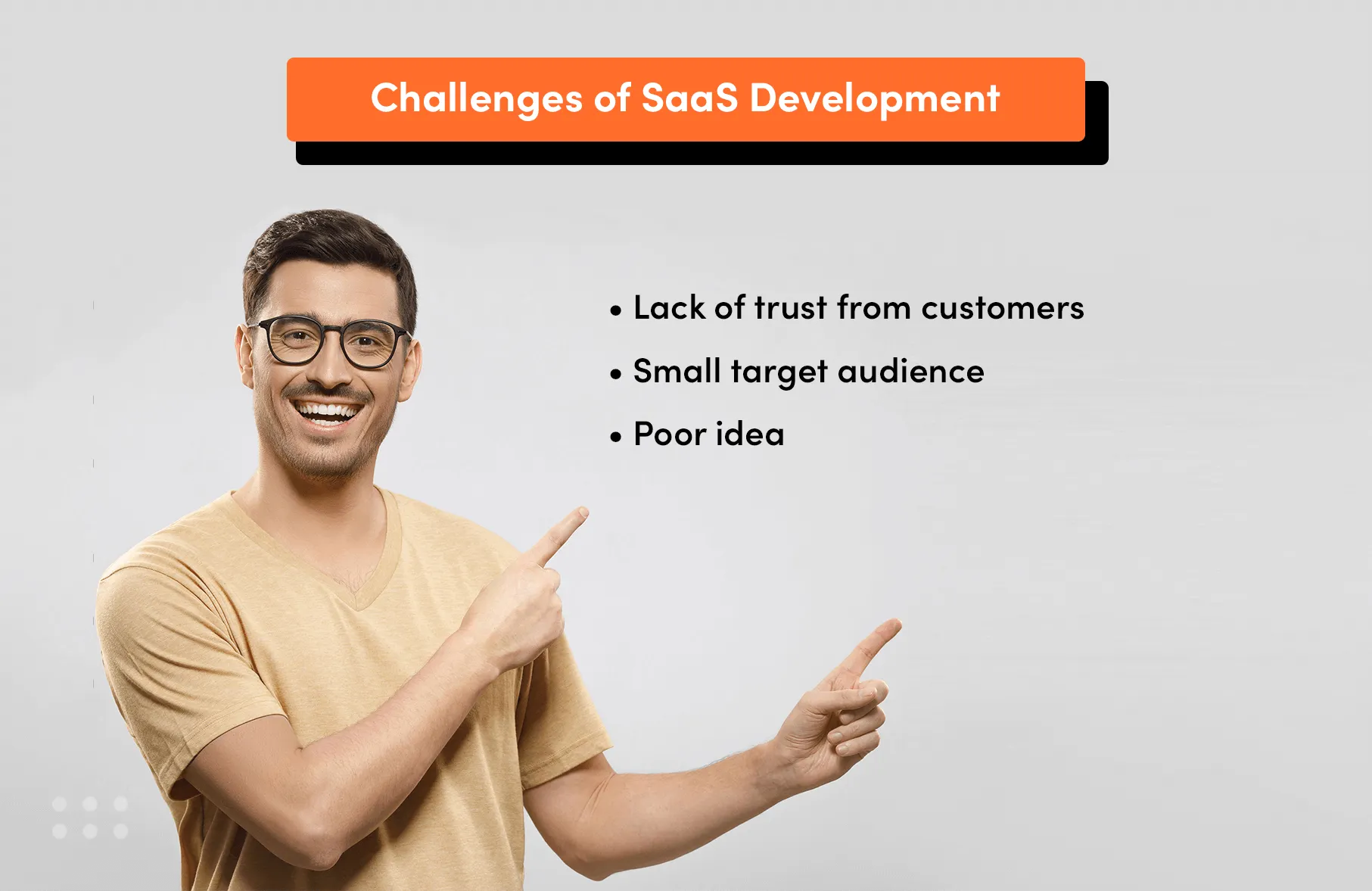
- Lack of trust from customers: without trust you will not have customers, especially in the SaaS model. Large SaaS companies have loyal users that will follow them everywhere, but when you are entering the market it may become a problem. To gain people’s trust show them security, and care about your user experience and user interface as well as your logo and branding.
- Small target audience: although having a one-of-a-kind product is daunting it is equally dangerous. With too small of an audience, your solution will not bring enough profit. To avoid that, try a horizontal development - by expanding functionalities. Do not forget to conduct a business analysis to further understand your target customers’ needs, competition and ongoing trends.
- Poor idea: there are in fact no bad ideas, just poor execution of good ideas. However, there is no sense in developing an application that will not meet current trends nor customer demand. For example, a CD recording application will not be of any use in 2020, but a CD recording that allows users to save and share the data would be much better.
A step-by-step guide to a successful SaaS app development
1. Define a unique value proposition that will help your SaaS stand out
There are many SaaS solutions to choose from.
Before you start developing your own, you need to completely understand the idea behind your product (business applications), how it will look like, and what will its functions be.
You also have to be aware of who your target customers are why they will want to use the solution and, therefore what will be necessary to help them reach their goals.
Always keep in mind that your goal is to:
- create something unique something future users will enjoy,
- want to keep using and recommend to others.
Start by thinking about:
- what you're passionate about that hasn't been created yet,
- what might frustrate your target audience with existing solutions, or even what bothers you personally,
At this point, it is worth also thinking about the UX/UI, customer support and third-party integrations. Maybe those are the things that your competitors are lacking.
You should research similar products on the market and understand how you can solve the users’ problems better. Market research helps to understand whether the SaaS project you are about to delve into has a potential audience as well as to find your customers’ aches and pains.
SaaS vendors should focus on showing the value to individual users first, instead of selling to managers or decision-makers who will not be using the software on a daily basis. Retaining customers is about continually showing them the value of your product.
To create an amazing SaaS solution you should know the significant feature that distinguishes it from other solutions and deliver it as soon as possible. This will give you the opportunity to test your SaaS idea with real users and after launch, add new functionalities.
Ask yourself which features are the most important and fulfil the app’s main purpose. Get rid of the ‘nice to haves’ before implementing the ‘musts’. Start with an MVP and share it with your audience.
2. Design the customer acquisition process
While developing your SaaS product you need to take into account the average cost that it takes to acquire a customer, and then how much profit the average customer brings in. In other words, you have to consider the customer acquisition cost (CAC) and compare it to the customer lifetime value (LTV). Your aim should be to recover the CAC in less than 12 months. The CAC and LTV will guide you through finding your most profitable and target clients.
You have to put yourself in your customers’ place and write User Stories consisting of 1-2 sentences describing how your system will respond to their actions. Do not forget to include the negative cases. Those ‘As a <type of user>, I want <some goal> so that <some reason>’ sentences will help you communicate your ideas to developers and web designers.
SaaS solutions have a longer sales cycle in comparison to other businesses. The average length of the sales cycle for Software as a Service is close to 3 months. In terms of business, it is a long time to maintain a relationship and convince somebody to buy your product. On the other hand, taking into consideration what goes into the buying process it is no surprise that the customers take their time.
You should aim to create a close relationship with your customer in order to start a successful collaboration without looking too desperate. First of all, your potential clients should get acquainted with your business, find out what are you about. In many cases, they will be at the very beginning of their road and may not even be aware that you are what they are missing.
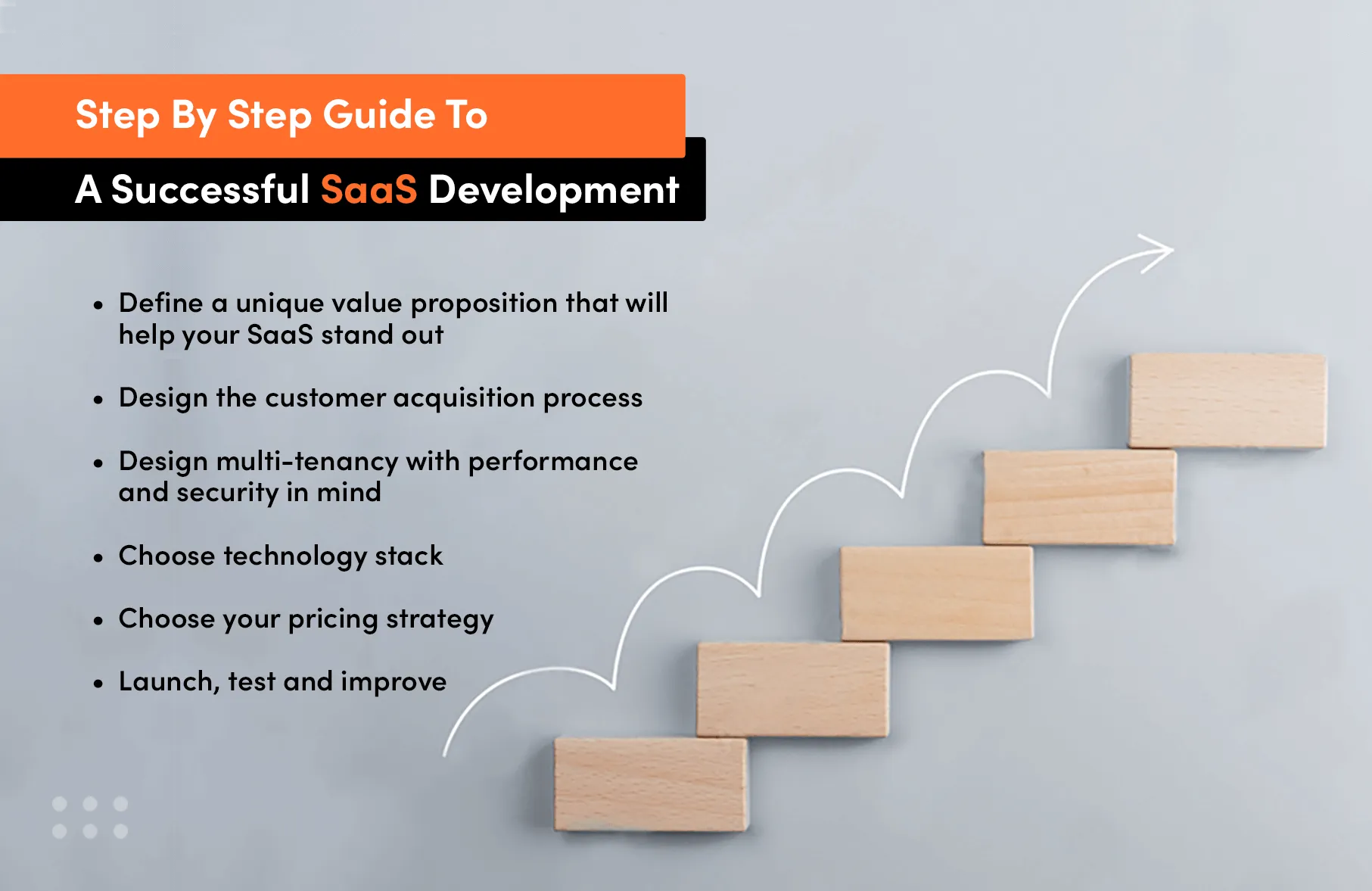
The second step would be to engage them with some of your content. Subscribing to a newsletter, and getting downloadable docs are what attract attention. In the next two steps, your consumers should explore your offering and hopefully convert into paying subscribers. You can make use of organic traffic by creating a SEO strategy, building your brand on events and showcasing your product on paid advertisements. Those activities will be based strictly on your target audience, but it is the best option to implement them at some point.
Your job is to retain customers and keep them coming back for more with exclusive newsletters and discounts for your loyal clients. Creating a supportive atmosphere is also an important part of customer retention. Boost your customer experience with welcoming emails and propose onboarding services to the new ones. Nurture your relationship through regular interactions.
Development of a SaaS architecture is connected to storing data in the cloud and many new customers may hesitate to do so. With the GDPR laws security of personal data is an even bigger problem, so make sure your product is GDPR compliant.
3. Design multi-tenancy with performance and security in mind
What is special about SaaS websites is the fact that they are self-service. This means that anyone who is interested in a given product can register and start using the service straight away. Users should be able to customize the solution to their requirements and needs.
Multi-tenancy means that a single instance of a software application is meant to serve multiple customers and it is the key to the success of your system. This is achieved either through separate databases or one database that displays adequate information to particular users. Thanks to that the development will be faster since developers can make use of a previously written code base to expand the service and apply changes. Multi-tenancy also means that the application should be very secure since the infrastructure is shared among all users.
If you want to find out more about multi-tenancy and why you should choose it, read our article Why choose multi-tenant architecture for SaaS application.
Application’s multi-tenancy can happen at different layers of the system:
- Infrastructure Layer
- Database Layer
- Application Layer
Based on those layers, we distinguish four types of multi-tenancy models that you can use to architect your SaaS application.
- Isolated Tenancy: the most basic level of tenancy where none of the layers are shared among the tenants. Every tenant has its own infrastructure, application and database. The infrastructure is isolated.
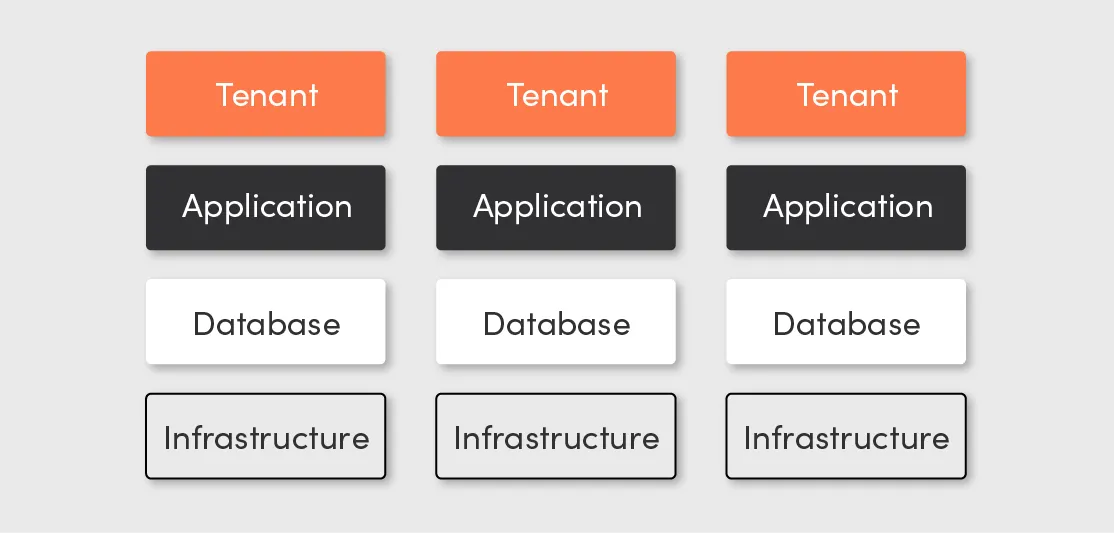
- Infrastructure Tenancy: here the infrastructure of the application is shared across tenants while the application and database remain separate.
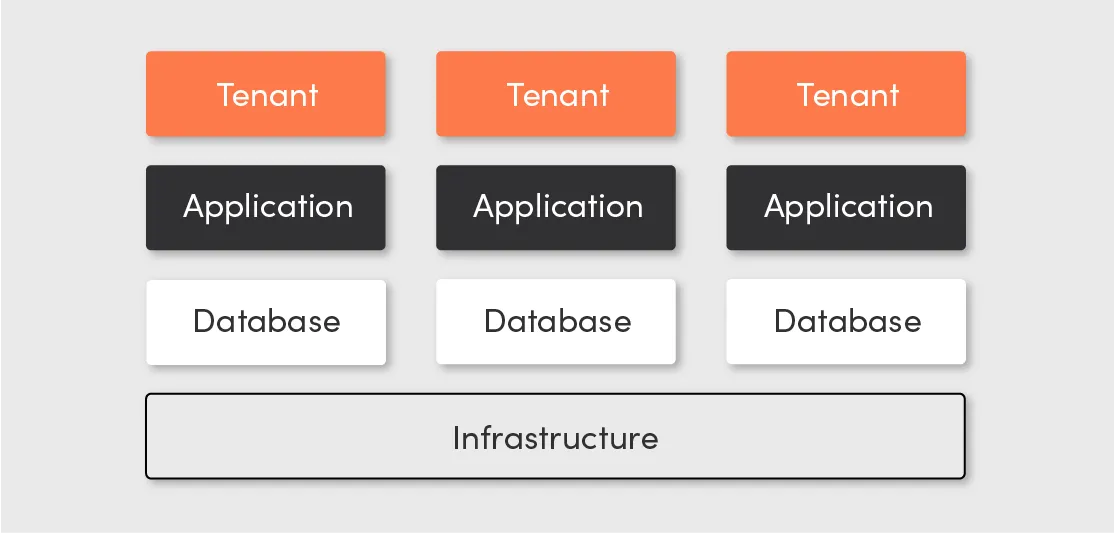
- Application Tenancy: the application code and infrastructure are shared among tenants while the database remains separate.
- Shared Tenancy: in the last tenancy model, infrastructure, database and application are shared among the tenants but each tenant in the database is considered to be separate.
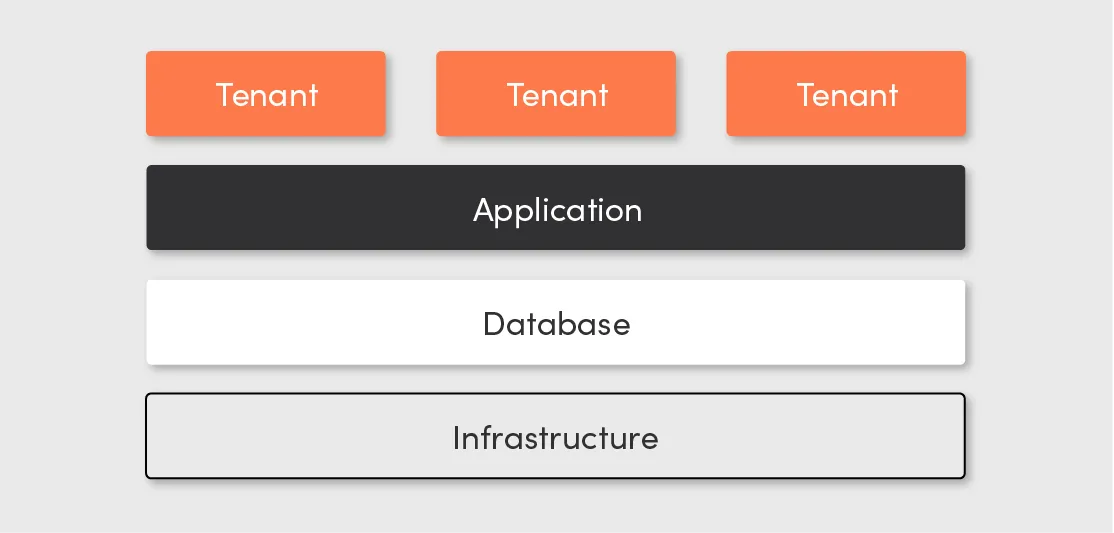
Your SaaS application should also be able to integrate with other services, for example, online payment solutions. Since your system will be available online it should be highly performant. An application with good performance should always be available and able to serve tenants of any size.
4. Choose a technology stack
Selecting a technology stack and finding SaaS developers is as important as market research. You need to have several tools for developing both client-facing components like JavaScript frameworks, server-side components like Ruby or Node.js and data storage with MySQL or PostgreSQL.
Estimate the platform’s scalability and potential profits to choose one that aligns with your use cases the best.
Then it is time to find developers that will help you bring your idea to life. Do not hesitate to ask for their opinion about the selected technologies. Bear in mind that the new technologies will have a limited talent pool with a rather fresh community around it.
5. Choose your pricing strategy
The SaaS pricing strategies can be the make or break of your cloud-based application. There are quite a few options available like:
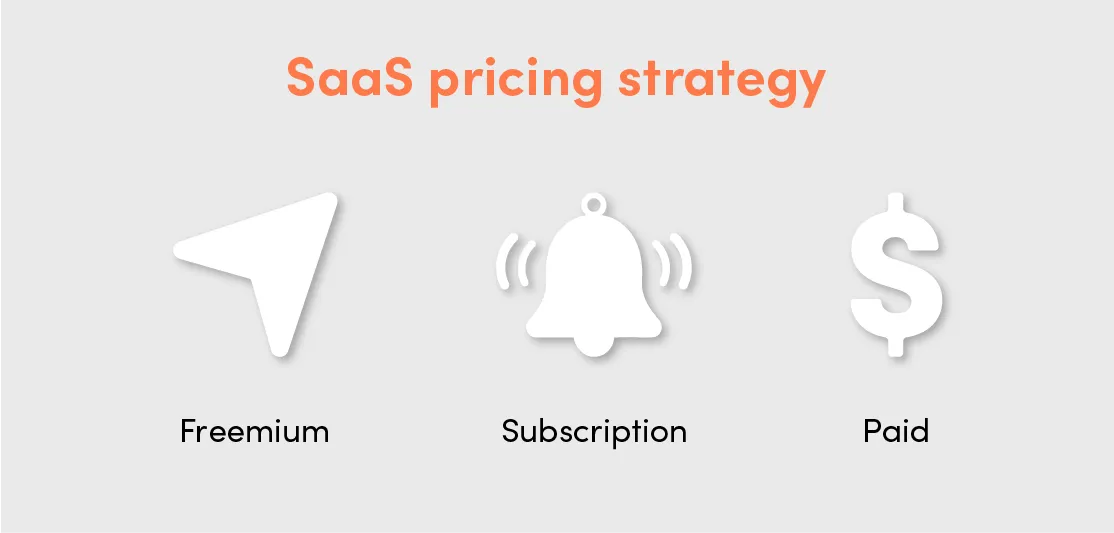
- Freemium: your app provides standard functionalities for free and can be expanded to more premium paid features. This model allows users to get to know the application, but remember to provide enough functions to attract customers while not being too generous
- Subscription: similar to freemium, this model is based on a recurring fee (eg. on a monthly basis) for extra content. It is best suited for content-focused applications like video hosting app
- Paid applications your application is available for a one-time purchase. The advantage is that even if the user stops using your product, you still get the money. On the other hand, customers will be less willing to pay the upfront costs if they are not sure of its quality and usefulness
6. Launch, test and improve
When your application is ready to be released it is time to test it in-house before releasing. If there are no bugs and your product is working as required you can launch it, therefore, converting the first users into testers. Apply feedback and move on to adding new features. This process is called the iterative and repetitive process.
Launching a new product is connected to a lot of marketing through social media, online communities and advertising. You can also start your own blog.
You should track metrics, even if it sounds boring and time-consuming. Find out which ones are relevant to your business and keep an eye on them. This will give you the opportunity to improve the performance, resolve problems as quickly as possible and help you make decisions with more confidence.
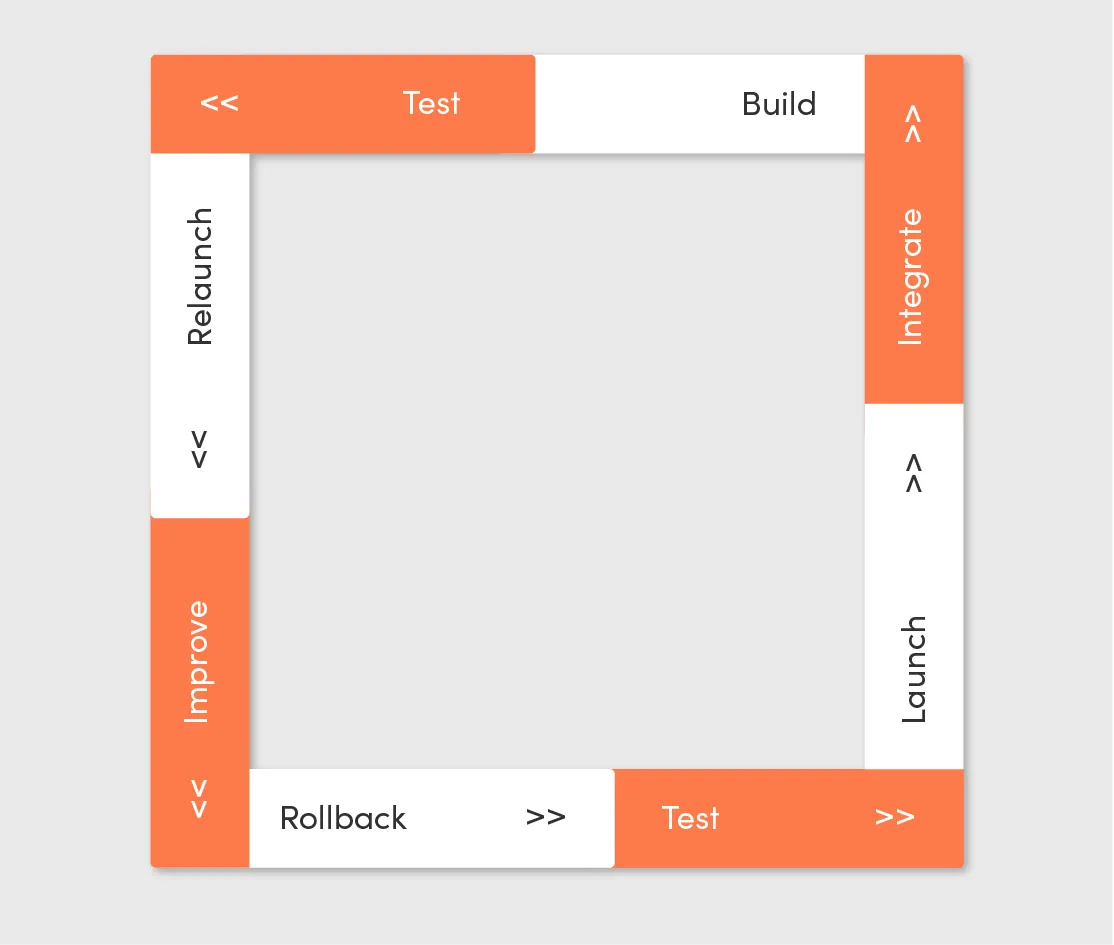
Summary
When designing a SaaS application we have to take into consideration many factors.
First of all, we should always remember that a good idea comes from proper market research and a well-thought-out client persona. After the initial process of creation, client acquisition is next. If you manage to acquire customers, it is also important to take care of your relationship by providing support and keeping a conversation going.
Finally, your application should be secure and compliant with international restrictions. Multi-tenancy in practical terms is what differentiates Software as a Service from other subscription-based solutions. A well-designed and developed SaaS application brings benefits to both the customer and the developer.
If you need help with the development of your SaaS website, check out SaaS Development Company and our expert developers team and read the article on Top 5 SaaS Development Challenges You Need To Know.
The cost to build a SaaS application varies widely based on complexity, ranging from $30,000 to $1 million or more. Basic apps with minimal features can cost between $30,000 to $100,000, while more complex or enterprise-level solutions can go beyond $250,000. The development team (in-house or outsourced), feature set, and third-party integrations also influence the price. Ongoing costs like cloud hosting, maintenance, and updates typically add 10-20% of the initial cost per year. Additional expenses include design, user experience, and marketing after launch.
Building a SaaS product without coding is not only possible but can also be a smart approach for entrepreneurs who want to quickly validate their ideas and enter the market. You can use no-code platforms like Bubble, Webflow, or Glide to build functional, scalable SaaS applications without writing a single line of code. However building a SaaS application with code, rather than relying solely on no-code platforms, offers greater flexibility, scalability, and customization. While no-code solutions are fast and inexpensive, they often come with limitations in terms of advanced functionality and performance. A coded solution allows developers to create highly customized features, integrate deeply with other systems, and optimize performance for large-scale growth. Moreover, owning the source code ensures full control over the product’s evolution, enabling you to build a more secure, robust, and future-proof application. In the long run, building with code provides more freedom to innovate and adapt to changing market demands.
To plan a SaaS application, start by defining the problem it will solve and the target audience it will serve. Next, outline the core features that provide immediate value, focusing on a Minimum Viable Product (MVP) for quick market entry. Choose the right technology stack and infrastructure that supports scalability and security from the start. Create wireframes and prototypes to visualize user flows and gather early feedback. Finally, develop a roadmap that includes phased development, regular updates, and strategies for user acquisition and retention.
